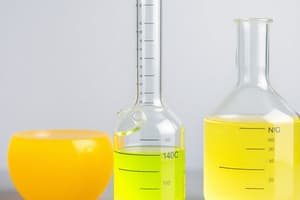Podcast
Questions and Answers
A dibasic acid dissociates to produce three H+ ions in aqueous solution.
A dibasic acid dissociates to produce three H+ ions in aqueous solution.
False (B)
The hydroxide ion is also known as the OH- ion.
The hydroxide ion is also known as the OH- ion.
True (A)
Hydrochloric acid is categorized as a weak acid because it fully dissociates in water.
Hydrochloric acid is categorized as a weak acid because it fully dissociates in water.
False (B)
Calcium hydroxide is considered a strong base due to its complete dissociation in water.
Calcium hydroxide is considered a strong base due to its complete dissociation in water.
A weak acid dissociates almost completely in water to produce hydrogen ions.
A weak acid dissociates almost completely in water to produce hydrogen ions.
A Brønsted-Lowry base is a proton donor.
A Brønsted-Lowry base is a proton donor.
Sodium hydroxide is classified as a strong base because it partially dissociates in water.
Sodium hydroxide is classified as a strong base because it partially dissociates in water.
Water can act as both a proton acceptor and a proton donor.
Water can act as both a proton acceptor and a proton donor.
According to the Bronsted-Lowry theory, an acid is a proton receptor.
According to the Bronsted-Lowry theory, an acid is a proton receptor.
Amphoteric substances can only act as acids.
Amphoteric substances can only act as acids.
H+ ions exist freely in water without forming bonds with other molecules.
H+ ions exist freely in water without forming bonds with other molecules.
A strong base is a poor proton acceptor.
A strong base is a poor proton acceptor.
Conjugate acid-base pairs differ by two protons.
Conjugate acid-base pairs differ by two protons.
Neutralization results in the formation of salt and water.
Neutralization results in the formation of salt and water.
Every base has a conjugate acid.
Every base has a conjugate acid.
The Arrhenius Theory can explain substances that act as both an acid and a base.
The Arrhenius Theory can explain substances that act as both an acid and a base.
The reaction of hydrochloric acid and sodium hydroxide produces sodium phosphate and water.
The reaction of hydrochloric acid and sodium hydroxide produces sodium phosphate and water.
Gaviscon is used to neutralise excess hydrochloric acid in the stomach.
Gaviscon is used to neutralise excess hydrochloric acid in the stomach.
Calcium oxide can be used to increase the acidity of soil.
Calcium oxide can be used to increase the acidity of soil.
Acid rain can be neutralised by adding limestone to lakes.
Acid rain can be neutralised by adding limestone to lakes.
In the Brønsted-Lowry theory, a strong acid is characterized as a poor proton donor.
In the Brønsted-Lowry theory, a strong acid is characterized as a poor proton donor.
Toothpaste is slightly basic to neutralise the acids found in food.
Toothpaste is slightly basic to neutralise the acids found in food.
Sulfuric acid is a strong dibasic acid because it can donate two hydrogen ions.
Sulfuric acid is a strong dibasic acid because it can donate two hydrogen ions.
The conjugate base of a strong acid is generally a stronger base than the conjugate base of a weak acid.
The conjugate base of a strong acid is generally a stronger base than the conjugate base of a weak acid.
Flashcards
Arrhenius Acid
Arrhenius Acid
A substance that dissociates in water to produce H+ ions.
Strong Acid
Strong Acid
A substance that almost completely dissociates in water to produce H+ ions.
Weak Acid
Weak Acid
A substance that only slightly dissociates in water to produce H+ ions.
Arrhenius Base
Arrhenius Base
Signup and view all the flashcards
Strong Base
Strong Base
Signup and view all the flashcards
Weak Base
Weak Base
Signup and view all the flashcards
Monobasic Acid
Monobasic Acid
Signup and view all the flashcards
Bronsted-Lowry Acid
Bronsted-Lowry Acid
Signup and view all the flashcards
Brønsted-Lowry Base
Brønsted-Lowry Base
Signup and view all the flashcards
Conjugate Acid
Conjugate Acid
Signup and view all the flashcards
Conjugate Base
Conjugate Base
Signup and view all the flashcards
Conjugate Acid-Base Pair
Conjugate Acid-Base Pair
Signup and view all the flashcards
Amphoteric Substance
Amphoteric Substance
Signup and view all the flashcards
Neutralization
Neutralization
Signup and view all the flashcards
Acid + Base Reaction
Acid + Base Reaction
Signup and view all the flashcards
Salt Formation
Salt Formation
Signup and view all the flashcards
Neutralization Reaction
Neutralization Reaction
Signup and view all the flashcards
Strong Di-basic Acid
Strong Di-basic Acid
Signup and view all the flashcards
Weak Mono-basic Acid
Weak Mono-basic Acid
Signup and view all the flashcards
Study Notes
Arrhenius Theory of Acids and Bases
- Acid: A substance that dissociates in water to produce H+ ions.
- Examples: HCl → H+ + Cl-, H₂SO₄ → 2H+ + SO₄²⁻, H₃PO₄ → 3H+ + PO₄³⁻
- Monobasic acid: Dissociates to give one H⁺ ion.
- Dibasic acid: Dissociates to give two H⁺ ions.
- Tribasic acid: Dissociates to give three H⁺ ions.
- Strong acid: Almost completely dissociates in water, e.g., HCl, H₂SO₄, HNO₃.
- Weak acid: Slightly dissociates in water, e.g., CH₃COOH, HCOOH.
- Base: A substance that dissociates in water to produce OH⁻ ions.
- Examples: NaOH → Na⁺ + OH⁻, Mg(OH)₂ → Mg²⁺ + 2OH⁻, Ca(OH)₂ → Ca²⁺ + 2OH⁻.
- Strong base: Almost completely dissociates in water to give hydroxide ions.
- Weak base: Slightly dissociates in water to give hydroxide ions.
Brønsted-Lowry Theory of Acids and Bases
- Acid (Brønsted-Lowry): A proton (H⁺) donor.
- Base (Brønsted-Lowry): A proton (H⁺) acceptor.
- Examples: HCl + H₂O → H₃O⁺ + Cl⁻ (HCl donates H⁺, H₂O accepts H⁺)
- Amphoteric substance: A substance that can act as both an acid and a base.
- Examples: Water (H₂O) can accept or donate a proton depending on the substance it interacts with.
Conjugate Acid-Base Pairs
- Conjugate acid-base pair: Any pair consisting of an acid and a base that differ by one proton.
- Example: CH₃COOH and CH₃COO⁻, HCl and Cl⁻.
- Acid → Conjugate base + H⁺ (e.g., CH₃COOH → CH₃COO⁻ + H⁺)
- Base + H⁺ → Conjugate acid (e.g., CH₃COO⁻ + H⁺ → CH₃COOH)
Neutralisation
- Definition: The reaction between an acid and a base to form a salt and water.
- General equation: Acid + Base → Salt + Water.
- Example: HCl + NaOH → NaCl + H₂O.
Uses of Neutralisation
- Medicine: Neutralizing excess stomach acid (using Gaviscon, containing sodium hydrogen carbonate).
- Agriculture: Neutralizing acidic soil with lime (calcium oxide, CaO).
- Environmental protection: Neutralizing acidic lakes with limestone.
- Miscellaneous: Neutralizing food acidity (with toothpaste), hair conditioner alkalinity (with shampoo), wasp sting (vinegar).
Comparing Arrhenius and Brønsted-Lowry Theories
- Arrhenius theory: Limited to water solutions, and limited to bases that produce OH⁻ ions. Does not consider hydronium ions.
- Brønsted-Lowry theory: Not limited to reactions in water, can explain cases where OH⁻ ions do not exist, and can account for hydronium ions.
Strong vs Weak Acids/Bases
- Strong acid: A good proton donor that almost completely dissociates in water.
- Weak acid: A poor proton donor that only slightly dissociates in water.
- Strong base: A good proton acceptor that almost completely dissociates in water.
- Weak base: A poor proton acceptor that only slightly dissociates in water.
Exam Questions (Examples)
- Distinguishing between strong and weak acids: Based on their behaviour in water (Arrhenius and Brønsted-Lowry theories).
- Conjugate bases: Identifying the conjugate base of an acid and comparing the strength of conjugate bases.
- Neutralisation: Writing balanced equations for neutralisation reactions and understanding the concept related to uses of neutralisation in various scenarios.
Studying That Suits You
Use AI to generate personalized quizzes and flashcards to suit your learning preferences.




